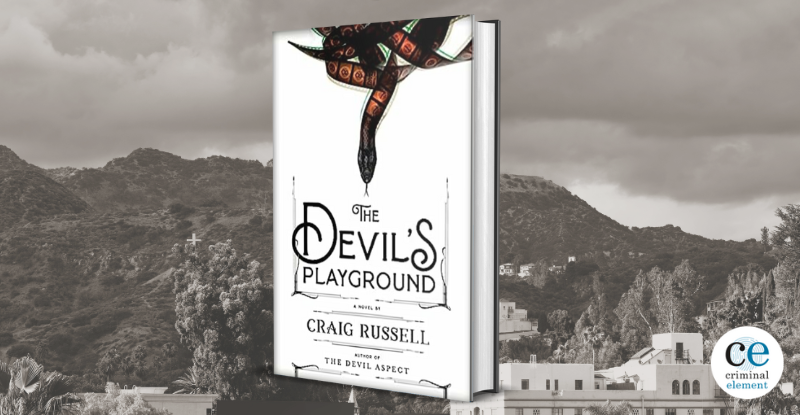Book Review: The Devil’s Playground by Craig Russell
By Doreen Sheridan
July 26, 2023
Hollywood in the silent era was famous for many things: craft and artistry, glamor and debauchery, champagne dreams come true, and the bitter salt tears of ruined lives. With film-making still in its infancy, movies and their makers came and went, sometimes leaving an indelible mark on the world’s imagination but just as often fading out into nothingness.
One movie with a controversial legacy was The Devil’s Playground, which became perhaps more famous for never being publicly screened than for the fact that it was allegedly the most frightening film ever made. With death and disaster plaguing the set, the subsequent movie was considered cursed, even before a fire destroyed every known reel. Rumor has it that only a single copy survived. As this novel opens in 1967, film historian Dr Paul Conway is hot on that missing copy’s trail.
Conway doesn’t believe in a supernatural curse, preferring far more human motivations for all the mystery surrounding the movie. As he explains:
“There’s this other theory that one scene in the movie—perhaps only a few frames—captures something.”
“Captures what?”
“In the mid-to-late Twenties, there were murders in Hollywood, young women who were supposed to be connected to important people, big names. Those few seconds of film are supposed to give a clue to the identity of the murderer–someone connected to the movie and connected to the kind of weird secret stuff that was going on in the background.”
“And you believe this?”
Conway shrugs. “It’s more believable than crazy conspiracies about the movie bringing a demon back to life.”
He’s not the only person skeptical of the supernatural. In 1927 Hollywood, practical, level-headed Mary Rourke works in the publicity department of Carbine International Pictures. Carbine’s latest production, the titular film, is turning into a giant headache, forcing Mary to constantly step in and smooth things over. Her job title would make it seem like her main focus lies in spreading the word regarding Carbine’s movies. In actuality she’s a general purpose fixer who spends most of her time keeping scandals involving the studio and its roster of artists hushed up and, most importantly, out of the newspapers.
In this endeavor, she’s joined by a select coterie of jaded professionals who work around the clock to make the epicenter of the silent film industry seem to the rest of the world like a wholesome place filled with the blameless and pure:
In the fantasy factory of Hollywood, it’s easy to lose your grip on reality, on the rules that guided you till now but that you’d checked at the door with your winter coat when you arrived in town. Stars burn bright, and frequently burn out. Every studio needs people like Mary Rourke, Sam Geller, and Doc Wilson to deal with the inconveniences of mental breakdowns, unwanted pregnancies, sex scandals, drunken brawls, automobile wrecks, attempted suicides, syphilis and gonorrhea infections, morphine and cocaine addictions, booze benders… The smooth cream stucco walls of the Appleton Clinic have drawn close around some of Hollywood’s darkest and most sordid secrets.
When Mary is called to the bedside of glamorous Norma Carlton, the star of The Devil’s Playground, the last thing she expects to find is a corpse. Worse, it looks like Norma committed suicide, decking herself out in jewelry as if for a final bow. A suicide would be a scandal that could potentially wreck the movie, so Mary immediately begins to spool up a fiction regarding Norma’s “lifelong heart condition” to release to the public. With a limited time frame to work with before the detective squad rolls in and gives the lie to her cover story, Mary quickly has the body shipped to the Appleton Clinic and has the studio’s investigative arm clear away any possible incriminating items, going for speed over accuracy.
So far, so business as usual… until Doc Wilson calls her in with terrible news. Norma’s death was set up to look like a suicide, but the ligature marks around her neck—hidden by an ornate necklace—indicate that someone killed her both deliberately and violently.
Mary has done a lot of questionable things for her employer, but being an accessory to murder is a new, unwelcome low. With her boss’ blessing, she begins investigating who would have wanted Norma dead, and more pertinently who would’ve known to dupe Mary and the studio into further obscuring their tracks. Her inquiries bring her to an even seedier side of Hollywood than she was already familiar with, as she unravels a conspiracy of lies surrounding a cult that preys on the young and beautiful. Will she be able to survive her run in with the devoted and crazed in the course of bringing a killer to justice, or will more than her hopes go up in flames as murder and arson stalk the apparently cursed set?
This is a tremendous work of historical noir, moving back and forth through time as it weaves threads of black magic and serial killings into its tapestry of the silent silver screen. Mary is the plucky, resourceful heart of the novel, rolling with the punches like a champ and never giving up in her pursuit of the crafty killer. I didn’t really understand the latter’s motivation for burning it all down in the end but I did love the way the story unfolded around the central mysteries. The mastery of silent film history was also exceptional, with terrific real life anecdotes—many far stranger than fiction!—sprinkled in to anchor the narrative in time and place. Expertly written and plotted, this excellent novel is a deeply satisfying amalgam of mystery and horror.
